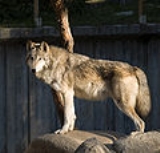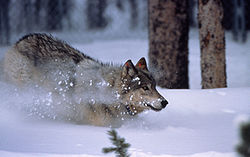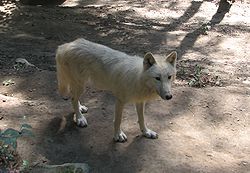
Mackenzie Valley Wolf
Encyclopedia
The Mackenzie Valley Wolf (Canis lupus occidentalis) also known as the Canadian Timber Wolf is perhaps the largest subspecies of Gray Wolf
in North America
. Its range includes parts of the western United States
, much of western Canada
, and Alaska
, including Unimak Island
in the Aleutians, and was introduced into Yellowstone National Park
and central Idaho
. The subspecies has since spread into other states, such as Washington, Oregon
, Nevada
, Northern California
, Colorado
, & Utah
.
 Mackenzie Valley Wolves typically stand about 32–36 inches (81–95 cm) at the shoulder and males weigh between 100 and 145 pounds (45–65 kg). The record is held by a wild wolf caught in Alaska in 1939 which weighed 175 pounds.
Mackenzie Valley Wolves typically stand about 32–36 inches (81–95 cm) at the shoulder and males weigh between 100 and 145 pounds (45–65 kg). The record is held by a wild wolf caught in Alaska in 1939 which weighed 175 pounds.
The Mackenzie Valley Wolf's thick, long limbs are proportionally built for traversing through rough terrain such as deep snow or the cliffy edges of the Rocky Mountains. Its deep chest hosts large lungs, letting the wolf breathe more efficiently at higher altitudes, and allowing it to exert huge amounts of stamina traveling up to 115 km (~70 miles) in one day. Its powerful neck is a very important adaptation; it has to be strong to support the wolf's large head and is crucial for bringing down prey. The Mackenzie Valley Wolf maximizes heat retention through such methods as using its bushy tail to cover its exposed nose during the winter. It sheds its undercoat during the summer months due to the hotter conditions.
The skull is 31 cm (12 inches) long and is armed with an impressive array of large canines and carnassial teeth which, when coupled with huge jaw muscles that are evident from the large sagittal crest
and wide zygomatic arches
, give it an incredible biteforce that is strong enough to break the bones of prey and even crack the femur of moose.
average 9.2 wolves with an average territory of 348 square miles (901.3 km²), while wolf packs in Idaho average 11.1 and 364 square miles (942.8 km²) territories.
, muskox, moose
, caribou, deer
, and elk
. Mackenzie Valley Wolves introduced into Yellowstone have taken down adult Plains Bison
, proving their success and adaptability in a whole new environment.
 The Mackenzie Valley Wolf was the subspecies used in the Yellowstone
The Mackenzie Valley Wolf was the subspecies used in the Yellowstone
introduction effort, where it has become a successful apex predator
much like it is in its vast northern range. In Yellowstone, it has been crucial in restoring environmental balance in that it has clamped down on the less fit members of the herds on which it feeds, thereby keeping large ungulate
numbers in check and allowing certain floral and faunal species to recover, promoting biodiversity. Wolves were also introduced in central Idaho and entered northwest Montana from Canada. The wolf population in the Northern Rockies has since grown to an estimated 1,300 animals.
The wolf population in Alaska is estimated at 7,500–11,000 wolves.
 The protection given to the Mackenzie Valley Wolf has allowed its population to rise dramatically, causing several young animals to leave the boundraries of Yellowstone and establish territories in areas where they may enter conflict with humans. In Wyoming and Idaho, 90 wolves have been killed to date because of livestock run-ins. In Montana, 32 wolves were killed in 2007 by federal agents. The Montana figure does not include an unknown number of wolves killed by ranchers defending their livestock. The death toll hit a record figure of 142 wolves in 2006.
The protection given to the Mackenzie Valley Wolf has allowed its population to rise dramatically, causing several young animals to leave the boundraries of Yellowstone and establish territories in areas where they may enter conflict with humans. In Wyoming and Idaho, 90 wolves have been killed to date because of livestock run-ins. In Montana, 32 wolves were killed in 2007 by federal agents. The Montana figure does not include an unknown number of wolves killed by ranchers defending their livestock. The death toll hit a record figure of 142 wolves in 2006.
Federal officials plan to remove gray wolves in the Northern Rocky Mountains
from the endangered species list in February 2008, although court challenges are considered inevitable and could delay a final delisting.
In the Rocky mountains, non-lethal responses to livestock kills, such as hazing wolves away from a ranch, are used when they can be pushed into an area without livestock.
Since its reintroduction to Yellowstone, the Mackenzie Valley wolf's possible involvement in the decline of elk
populations has been a subject of controversy. On one hand, Yellowstone officials have stated that computer analysis indicates that there is greater justification for believing that the human hunting rate and severe climate account for the majority of the decline, with wolf predation amounting to very little. Others state that the decline is an inevitable result of an exploded wolf population.
Gray Wolf
The gray wolf , also known as the wolf, is the largest extant wild member of the Canidae family...
in North America
North America
North America is a continent wholly within the Northern Hemisphere and almost wholly within the Western Hemisphere. It is also considered a northern subcontinent of the Americas...
. Its range includes parts of the western United States
United States
The United States of America is a federal constitutional republic comprising fifty states and a federal district...
, much of western Canada
Canada
Canada is a North American country consisting of ten provinces and three territories. Located in the northern part of the continent, it extends from the Atlantic Ocean in the east to the Pacific Ocean in the west, and northward into the Arctic Ocean...
, and Alaska
Alaska
Alaska is the largest state in the United States by area. It is situated in the northwest extremity of the North American continent, with Canada to the east, the Arctic Ocean to the north, and the Pacific Ocean to the west and south, with Russia further west across the Bering Strait...
, including Unimak Island
Unimak Island
Unimak Island is the largest island in the Aleutian Islands chain of the U.S. state of Alaska. It is the easternmost island in the Aleutians and, with an area of 1,571.41 mi² , the ninth largest island in the United States and the 134th largest island in the world. It is home to Mount...
in the Aleutians, and was introduced into Yellowstone National Park
Yellowstone National Park
Yellowstone National Park, established by the U.S. Congress and signed into law by President Ulysses S. Grant on March 1, 1872, is a national park located primarily in the U.S. state of Wyoming, although it also extends into Montana and Idaho...
and central Idaho
Idaho
Idaho is a state in the Rocky Mountain area of the United States. The state's largest city and capital is Boise. Residents are called "Idahoans". Idaho was admitted to the Union on July 3, 1890, as the 43rd state....
. The subspecies has since spread into other states, such as Washington, Oregon
Oregon
Oregon is a state in the Pacific Northwest region of the United States. It is located on the Pacific coast, with Washington to the north, California to the south, Nevada on the southeast and Idaho to the east. The Columbia and Snake rivers delineate much of Oregon's northern and eastern...
, Nevada
Nevada
Nevada is a state in the western, mountain west, and southwestern regions of the United States. With an area of and a population of about 2.7 million, it is the 7th-largest and 35th-most populous state. Over two-thirds of Nevada's people live in the Las Vegas metropolitan area, which contains its...
, Northern California
Northern California
Northern California is the northern portion of the U.S. state of California. The San Francisco Bay Area , and Sacramento as well as its metropolitan area are the main population centers...
, Colorado
Colorado
Colorado is a U.S. state that encompasses much of the Rocky Mountains as well as the northeastern portion of the Colorado Plateau and the western edge of the Great Plains...
, & Utah
Utah
Utah is a state in the Western United States. It was the 45th state to join the Union, on January 4, 1896. Approximately 80% of Utah's 2,763,885 people live along the Wasatch Front, centering on Salt Lake City. This leaves vast expanses of the state nearly uninhabited, making the population the...
.
Anatomy

The Mackenzie Valley Wolf's thick, long limbs are proportionally built for traversing through rough terrain such as deep snow or the cliffy edges of the Rocky Mountains. Its deep chest hosts large lungs, letting the wolf breathe more efficiently at higher altitudes, and allowing it to exert huge amounts of stamina traveling up to 115 km (~70 miles) in one day. Its powerful neck is a very important adaptation; it has to be strong to support the wolf's large head and is crucial for bringing down prey. The Mackenzie Valley Wolf maximizes heat retention through such methods as using its bushy tail to cover its exposed nose during the winter. It sheds its undercoat during the summer months due to the hotter conditions.
The skull is 31 cm (12 inches) long and is armed with an impressive array of large canines and carnassial teeth which, when coupled with huge jaw muscles that are evident from the large sagittal crest
Sagittal crest
A sagittal crest is a ridge of bone running lengthwise along the midline of the top of the skull of many mammalian and reptilian skulls, among others....
and wide zygomatic arches
Zygomatic bone
The zygomatic bone is a paired bone of the human skull. It articulates with the maxilla, the temporal bone, the sphenoid bone and the frontal bone. The zygomatic is homologous to the jugal bone of other tetrapods...
, give it an incredible biteforce that is strong enough to break the bones of prey and even crack the femur of moose.
Social behaviour
In Alaska, pack sizes are generally 6–12 wolves, with some packs as large as 20–30. Territory size averages 600 square miles (1,554 km²). Wolf packs in YellowstoneYellowstone National Park
Yellowstone National Park, established by the U.S. Congress and signed into law by President Ulysses S. Grant on March 1, 1872, is a national park located primarily in the U.S. state of Wyoming, although it also extends into Montana and Idaho...
average 9.2 wolves with an average territory of 348 square miles (901.3 km²), while wolf packs in Idaho average 11.1 and 364 square miles (942.8 km²) territories.
Diet
The majority of the Mackenzie Valley Wolf's prey includes wild boar, wood bisonWood Bison
The Wood Bison, Bison bison athabascae, also called Mountain Bison, Wood Buffalo or Mountain Buffalo, is a distinct northern subspecies or ecotype of the American Bison...
, muskox, moose
Moose
The moose or Eurasian elk is the largest extant species in the deer family. Moose are distinguished by the palmate antlers of the males; other members of the family have antlers with a dendritic configuration...
, caribou, deer
Deer
Deer are the ruminant mammals forming the family Cervidae. Species in the Cervidae family include white-tailed deer, elk, moose, red deer, reindeer, fallow deer, roe deer and chital. Male deer of all species and female reindeer grow and shed new antlers each year...
, and elk
Elk
The Elk is the large deer, also called Cervus canadensis or wapiti, of North America and eastern Asia.Elk may also refer to:Other antlered mammals:...
. Mackenzie Valley Wolves introduced into Yellowstone have taken down adult Plains Bison
Plains Bison
The Plains Bison or Common bison is one of two subspecies/ecotypes of the American Bison, the other being the Wood Bison . Furthermore, it has been suggested that the Plains Bison consists of a northern and a southern subspecies, bringing the total to three...
, proving their success and adaptability in a whole new environment.
Hunting
Mackenzie Valley Wolves are not the most successful when it comes to killing moose, with a success rate as low as 10%. When preying on medium to large-sized animals such as caribou and elk, pack members will in turn chase an ill or disadvantaged prey and wait till they tire. They will then slowly start to tear away at the prey, attacking the flanks, the muzzle, neck, and hindquarters. Prey usually die from disembowelment, shock, and exhaustion caused by lack of air through suffocation and blood loss. For small prey, wolves will bite down and sever the jugular veins and windpipe, sometimes even shaking to break the animals vertebrae. http://www.aws.vcn.com/alaska.htmlCurrent status and history

Yellowstone National Park
Yellowstone National Park, established by the U.S. Congress and signed into law by President Ulysses S. Grant on March 1, 1872, is a national park located primarily in the U.S. state of Wyoming, although it also extends into Montana and Idaho...
introduction effort, where it has become a successful apex predator
Apex predator
Apex predators are predators that have no predators of their own, residing at the top of their food chain. Zoologists define predation as the killing and consumption of another organism...
much like it is in its vast northern range. In Yellowstone, it has been crucial in restoring environmental balance in that it has clamped down on the less fit members of the herds on which it feeds, thereby keeping large ungulate
Ungulate
Ungulates are several groups of mammals, most of which use the tips of their toes, usually hoofed, to sustain their whole body weight while moving. They make up several orders of mammals, of which six to eight survive...
numbers in check and allowing certain floral and faunal species to recover, promoting biodiversity. Wolves were also introduced in central Idaho and entered northwest Montana from Canada. The wolf population in the Northern Rockies has since grown to an estimated 1,300 animals.
The wolf population in Alaska is estimated at 7,500–11,000 wolves.

Federal officials plan to remove gray wolves in the Northern Rocky Mountains
Rocky Mountains
The Rocky Mountains are a major mountain range in western North America. The Rocky Mountains stretch more than from the northernmost part of British Columbia, in western Canada, to New Mexico, in the southwestern United States...
from the endangered species list in February 2008, although court challenges are considered inevitable and could delay a final delisting.
In the Rocky mountains, non-lethal responses to livestock kills, such as hazing wolves away from a ranch, are used when they can be pushed into an area without livestock.
Since its reintroduction to Yellowstone, the Mackenzie Valley wolf's possible involvement in the decline of elk
Elk
The Elk is the large deer, also called Cervus canadensis or wapiti, of North America and eastern Asia.Elk may also refer to:Other antlered mammals:...
populations has been a subject of controversy. On one hand, Yellowstone officials have stated that computer analysis indicates that there is greater justification for believing that the human hunting rate and severe climate account for the majority of the decline, with wolf predation amounting to very little. Others state that the decline is an inevitable result of an exploded wolf population.

